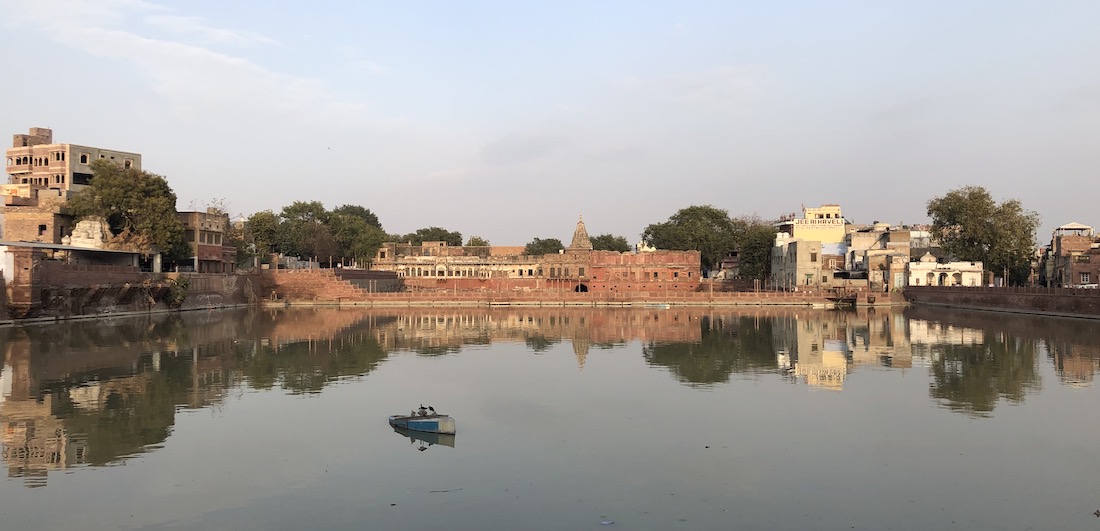Jodhpur is the fabled blue city of Rajasthan, its skyline dominated by the mighty fortress of Mehrangarh. After the chaos of Delhi and Agra, it offered a slower pace of life, warmer climes, fascinating history and a friendly vibe. Of all the cities we visited, Jodhpur was my favourite.
We flew down from the capital on a pleasant late January morning, tested by the slow-moving queues, clunky IT and reassuringly strict security of New Delhi Airport. The flight was little more than 45 minutes on a clapped out 737 of Jet Airways subsidiary Jet Konnect, and we landed at Jodhpur’s modest airport on time and free of incident in brilliant sunshine. We’d booked a car to take us to our city centre accommodation, the Pal Haveli, freeing us from the eager cab drivers who milled about in the car park. Jodhpur’s old town is rightly famous, enclosed within ancient city walls and painted with pastel blue shades, but it has long since burst out of its historic boundaries and sprawls out into the Thar Desert. Its suburbs are not the prettiest of sights…
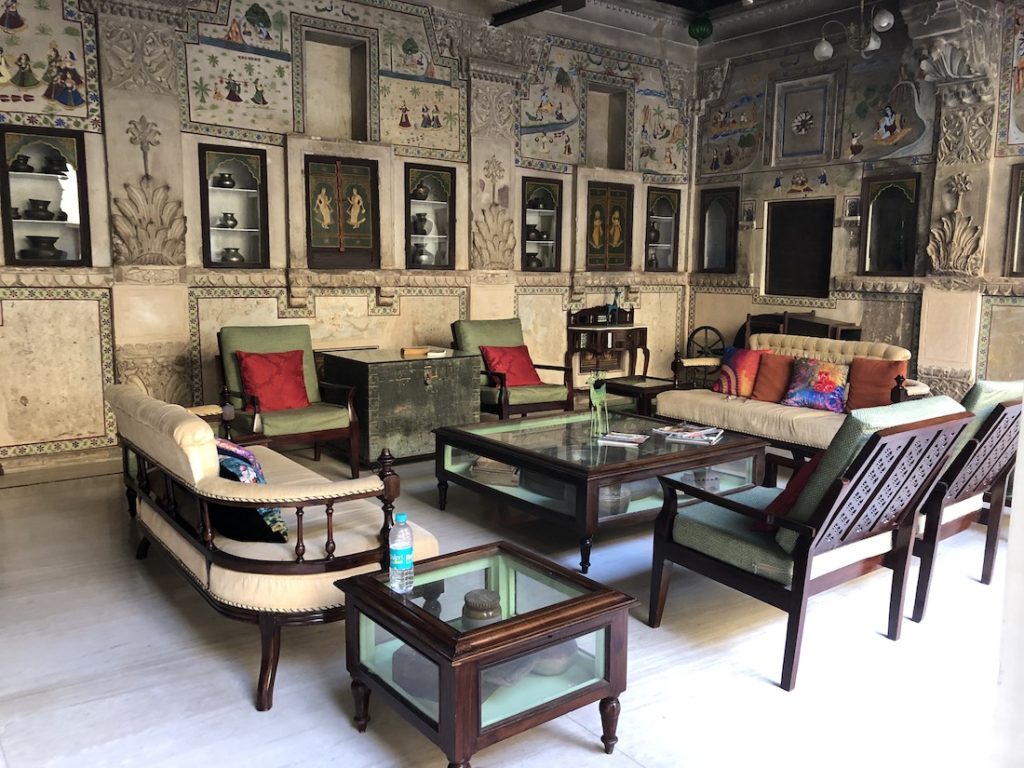
Our accommodation, the Pal Haveli, is a rambling 18th century townhouse, with courtyards, nooks and crannies, and sits in the heart of the old town close to the Gulab Sagar Lake (pictured top). This man-made and picturesque stretch of water, surrounded by historic if crumbling buildings, was built as a source of fresh water for the town but these days can pong a bit on a hot day. For some reason, locals found its banks a useful place to dump rubbish and feed cattle and stray dogs, which was all a bit depressing. Over the road at the haveli we’d opted for one of the best rooms, set on a quiet courtyard and with the most exquisite decoration I’ve ever seen in a hotel bedroom. There are comfortable seating areas throughout the building, and some rooms and public spaces are given over to displays of local antiques and museum pieces.
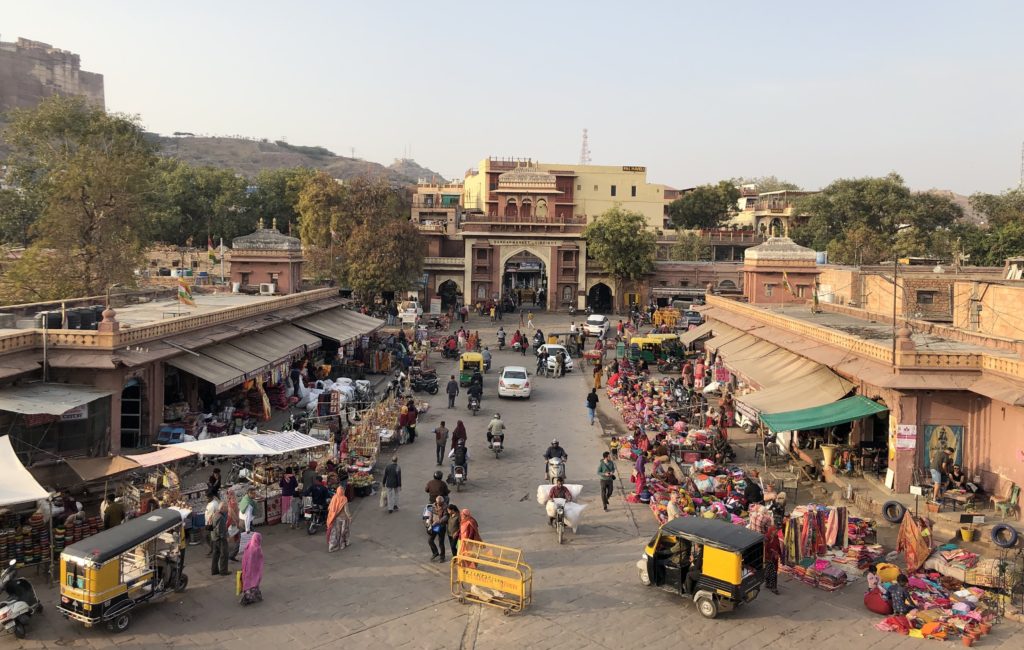
Just a few yards from the haveli’s giant wooden entrance gates is the heart and soul of Jodhpur, the Sardar Market and its majestic clocktower. An explosion of colour, sights and sounds, the market is enclosed by sandstone walls and accessed by majestic colonial-era gates. We climbed the stairs inside the clocktower to get better views of the surroundings and managed to dodge the pigeons, which are as numerous in the city as they are everywhere else in India. The streets beyond the market are just as busy with stallholders, tradesmen and craftspeople, antiques shops and food stalls. Napoleon once said that England was a nation of shopkeepers, but Indians do it a damn sight better than we do these days. We dodged motorbikes and tuk tuks, dog and cow poo as we explored, pleasantly surprised that touts were few and far between compared to Delhi and Agra.
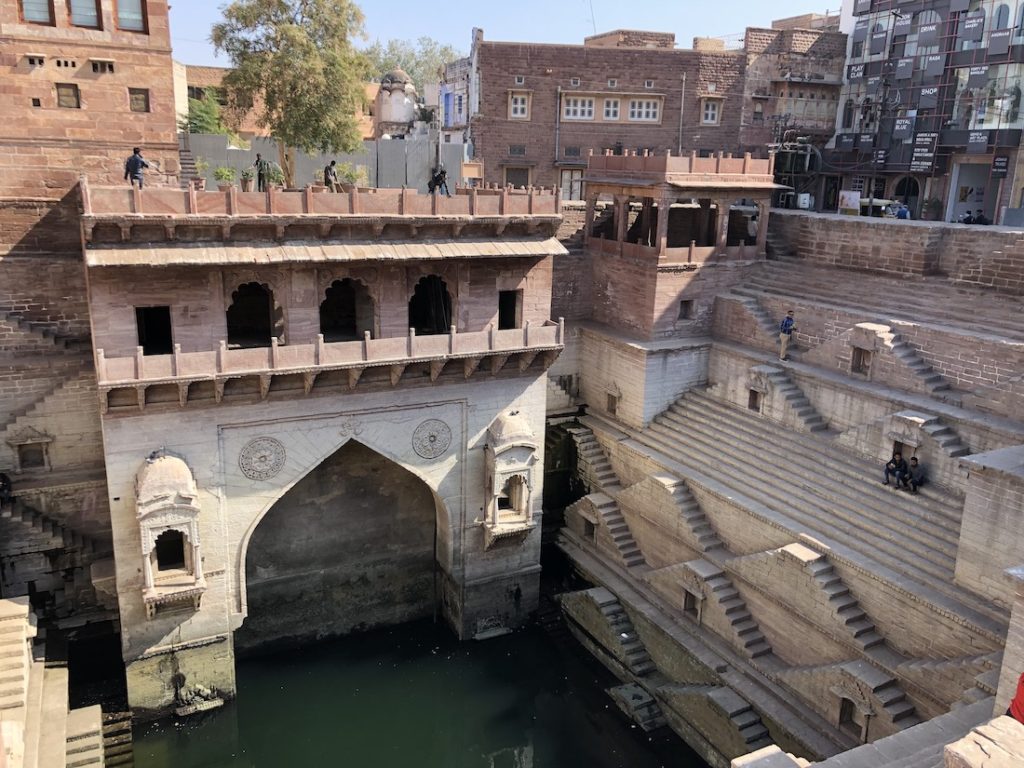
A Jodhpur highlight is the Toorji Ka Jhalra Step Well, one of many such structures around the Indian sub-continent that were built to store precious water. Jodhpur’s restored well was built in the 18th century and its geometric architecture is fascinating. Not only is it a popular spot with tourists, but locals love to hang out there, passing the time of day and playing on their mobiles, smoking ciggies (or illegal substances). As we sat in the neighbouring Stepwell Cafe, a fully clothed youth decided to do a running jump from the top of the well into the water far below for the benefit of his friend’s camera. And not happy with the first effort, he did it again. We decided to stay dry and enjoy a glass of wine or two in the modern and welcoming cafe instead, watching the comings and goings. The well and its neighbourhood have been the subject of an expensive renovation project in recent years and there’s a fancy hotel nearby as well as a smart range of shops and boutiques. I can’t imagine that the stylish homewares and outfits on sale would be within reach of most locals but the stores made a change from the usual Indian market stalls.
Later in our stay, exploring the grungy streets around the Gulab Sagar Lake, we stumbled across another step well, the Mahila Bagh Ka Jhalra, which is sadly quite neglected. The water far below looked fetid and there was nobody about, but perhaps one day it will get the renovation and fancy cafe treatment like its near neighbour.
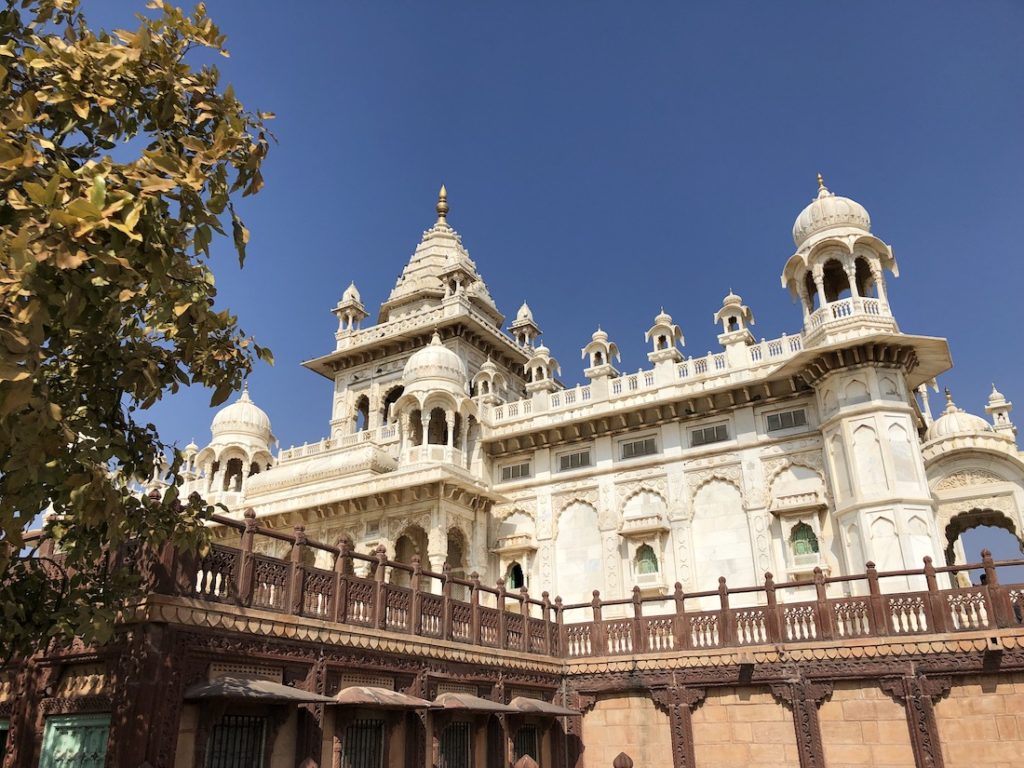
On another day we walked north from the haveli, through colourful narrow lanes to the Jaswant Thada, a striking white marble mausoleum and cremation ground on the outskirts of town. With excellent views of Jodhpur’s famous fort, the site stands on the edge of a small lake and desert rock park, where baying stray dogs had found themselves a home for a few hours. Birds of prey hovered above the scrub and ducks played on the water. The mausoleum was built in 1899 in memory of the then maharaja Jaswant Singh II and is surrounded by pleasant gardens and a number of smaller mausoleums. It’s a wonderfully peaceful place to spend an hour, away from the crowds and bustle of Jodhpur, and it’s easy to see why the royal family chose it as the site of their memorials.
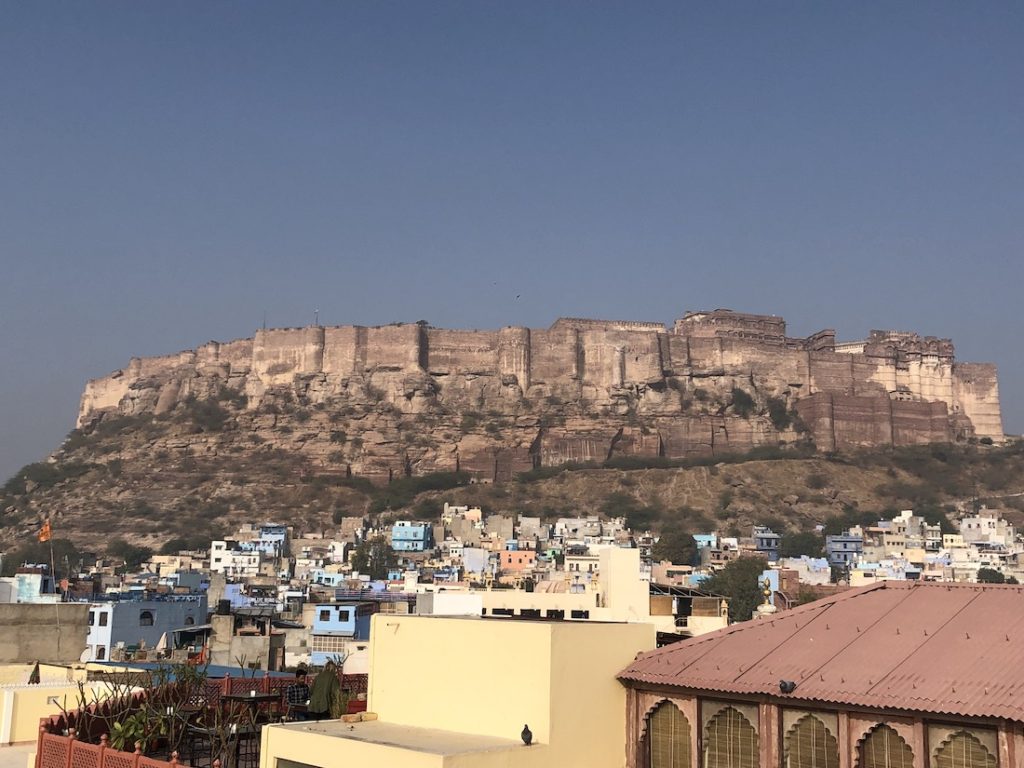
We walked back to the city centre past a statue of Rao Jodha, the 15th century ruler of what is now Rajasthan and the man who founded the city of Jodhpur and its monumental fort. His descendants still live locally and although the Indian princes have long since lost their official status and state hand-outs, the maharaja is better off than most and lives in a bulky palace on a bluff out in the suburbs. So we got a tuk tuk and went to have a nose around. Sadly, the tour is limited to a small museum because much of the Umaid Bhawan Palace is now a swanky Taj hotel that’s out of bounds for anyone but guests. The grounds were busy with visitors on such a warm and sunny day, and many were having a good look at the Maharaja’s collection of powerful, luxury cars from the early 20th century.
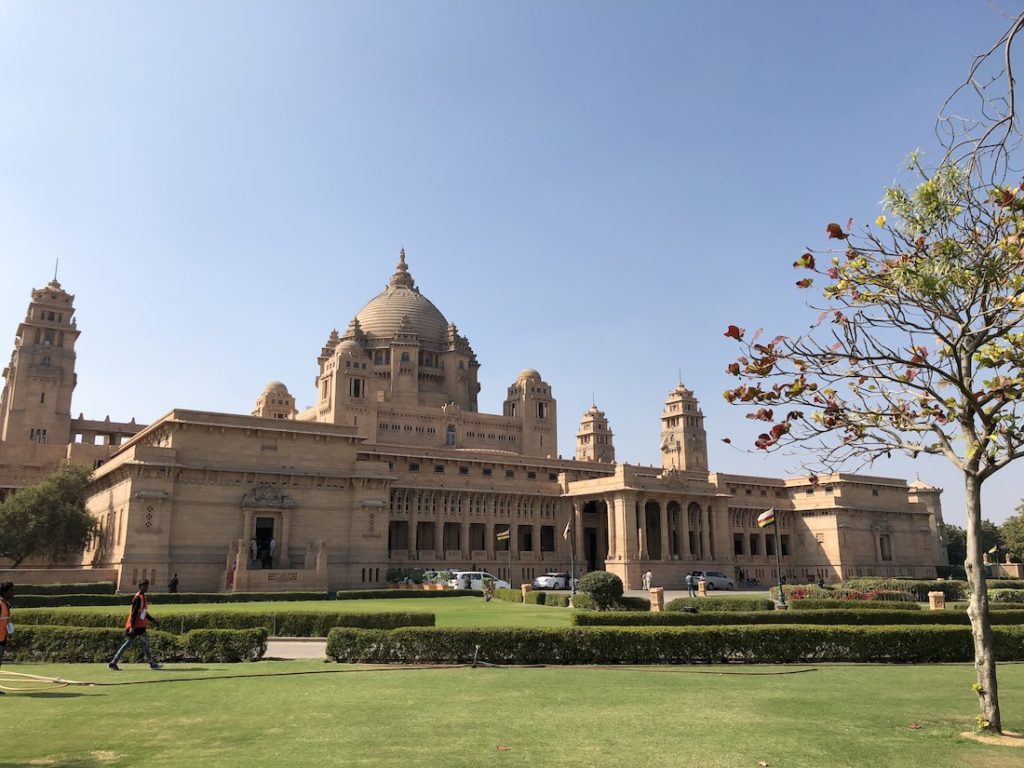
The museum tells the story of how the palace was built in the early 20th century, supposedly in response to the then ruler’s desire to give locals much-needed work during a time of famine. It’s a nice story but it struck me as being a rather selfish act, for he could just as easily have chosen to build decent homes and civic infrastructure for the poor of Jodhpur instead. Still, the museum is good enough, features plenty of the royal family’s goods and chattels and is a lot more extensive than the guide books had suggested it would be. As for the palace itself, it’s an odd confection that doesn’t quite work to my untrained eye, a strange mix of east and west that doesn’t really know what it wants to be. We stopped for an ice cream before getting the tuk tuk back into town, through the crowds, dust and drama of the afternoon markets.
The haveli didn’t just provide us with a bed for the night, it also fed us, for it boasts one of the most popular restaurants in town – Indique. Set on the rooftop, it offers the most breathtaking of views of Jodhpur city, the nearby lake and the majestic, illuminated Mehrangarh. During our stay, stars twinkled above us but it was cool and breezy as we tucked into excellent traditional Indian dishes – rogan josh and butter chicken to name but two – and drained chilled bottles of Kingfisher. Indique is one of many rooftop restaurants in the city but Jodhpur isn’t really a boozer’s paradise. However, we found a welcoming bar on the roof of the Raas Hotel, a posh, trendy destination beside the step well. Fire pits chucked out the heat and smoke as we downed glasses of wine ahead of a meal in their ground floor restaurant. There’s no doubt that the Raas is a fabulous (if expensive) destination but as we returned to our accommodation down the road, I felt happy that we’d chosen to stay somewhere so rich in the traditions and craftsmanship of India.

